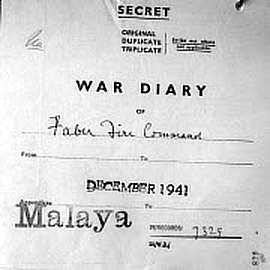Fort Siloso: History — War Diaries

Extracts & Information From Faber Fire Command War Diary

Night 8/9 Feb. P LABA: Japanese landing on NW Coast of Singapore Island. P. Laba Bty received calls for Harassing Fire on to all likely embarkation points on Southern Johore Coast between 12 midnight and 0400 hrs. The calls emanated from 44th Ind Infantry Bde and AIF......At 0700 hrs P. Laba Battery dive bombed and shelled. Both Gun Emplacements hit..........
9·2·42: At 0900 hrs F.C. ordered LT FITCH Siloso Section and an HKSRA demolition party from Labrador Section to proceed at once to P. Laba with fresh demolition equipment to carry out demolitions to the fort. The party arrived at Laba at 12 noon and by 2000 hrs all demolitions to Guns Magazines Engine Rooms CASLs and stores were completed, and party successfully withdrew without loss during the night of 9/10 to Faber covered by the Malay Company.......
 11 February 1942: “At 1200 hrs SILOSO and LABRADOR forts engaged enemy concentrations at the WEST end of the WEST COAST ROAD. (MR 7312) and JURONG RIVER position (approx 60 rounds HE expended) at request of H.Q. 1 M.I.B.” This area Target had been silently registered previously.
11 February 1942: “At 1200 hrs SILOSO and LABRADOR forts engaged enemy concentrations at the WEST end of the WEST COAST ROAD. (MR 7312) and JURONG RIVER position (approx 60 rounds HE expended) at request of H.Q. 1 M.I.B.” This area Target had been silently registered previously.
Note: The map reference above is shaded in the image to the right. It is approximately the location of the Hong Leong Shopping Centre.
“At 1630 hrs SILOSO FORT, and central Barrack area were heavily bombed from Air. Damage was caused to Reserve Water Tank and pipeline from the Barracks to the Fort”
12 February 1942: “Siloso engaged targets on the West Coast on the Coast Road and fuel tanks on Pulau Bukom to deny the oil they contained to the Japanese. Further land targets were engaged on the 13th.
13th and 14th February: The Siloso guns were turned on the oil installations on Pulau Bukom and Pulau Sebarok to the south west of Blakang Mati. This action was carried out in an attempt to destroy the installations before the Japanese could take them over. They also engaged land targets in the area of West Coast Road at 1100 on the 13th.
At 2115 on the 13th, a boat was, “observed approaching the Western Entrance Contrary to orders. Two rounds were fired and it was sunk. Subsequently it turned out that the occupants were stragglers of the AIF, one of whom reached the shore, wounded and was sent to Hospital”.
On the night of 13/14 February 1942: A ship was detected outside the minefields protecting the approach to Keppel Harbour. Information about this ship, stating that no British ship was in the area, was signalled from Fort Canning to C.C.M. Macleod-Carey, Second-in-Command of 7 Coast Artillery Regiment, who was in his Command Post on Mount Faber. Macleod-Carey ordered the searchlights at Labrador, Siloso and Serapong to sweep the area for the ship. A vessel of some 8,000 tons was quickly illuminated by the searchlights. It was then challenged by means of an Aldis lamp, but failed to respond with the correct identification signals. A naval rating, using a copy of ‘Jane's Fighting Ships’, identified the vessel as being a Japanese landing craft carrier, and the 6-Inch batteries at Labrador and Siloso were ordered to open fire. Hits were registered almost immediately on the ship and it sank within a few minutes. This was what the guns had been designed for, and they performed exactly as required.
Macleod-Carey’s version of events has been criticised for being incorrect, and it has been stated that no large ship was sunk, only a Tongkang (wooden trading vessel). The Fort Record Book states, “Japanese Troop Transport Engaged and Destroyed”. A handwritten account authored in captivity records, “A sea target which was not identified by *words indecipherable* drifting slowly from West to East inside No 2 minefield between P. SEBAROK and ST. JOHN’S WEST. This target was quickly set on fire and sunk. The A.F.C. reported to the F.C that this ship was a suspicious vessel with a big front and built up bridge. This was confirmed by PWSS (Port War Signal Station). I am of the definite opinion that this craft was a drifting Tongkang with oil drums on board which had been tied to the wharf on P. SEBAROK (Middle Island) and broke loose when the denial of the Oil Tanks on the Island was carried out......”
14th February: At 0415 Hours, as recorded by Lt Col. H.D. St. G. Cardew, Royal Artillery, the Commander of 7 Coast Regiment, HQFD gave the order for the guns on Blakang Mati to be ‘spiked’to prevent them falling into Japanese hands. At 0500 Hours the gunners destroyed the Siloso guns blowing the breeches off them with 40lb explosive charges. The photo on the right shows the Siloso No. 2 Gun with its Breech blown off by a gelignite charge. Part of the concrete splinter cover can be seen above the gun. The 12 Pounder at Siloso Point was tipped in to the sea. The CASLs were also destroyed. Personnel were withdrawn to Fort Connaught at 0630 hrs.
At 1430 hrs, F.C. sent patrols to Siloso to report on the situation there. The patrols found no signs of a Japanese presence. Another patrol was sent at at 1730 hrs on the 15th. They remained all night, and on return reported a weak enemy patrol had landed near the machine gun post at Siloso Bay.
All other Coast Artillery Batteries on Blakang Mati and Pulau Brani are destroyed on the 14th to prevent them falling into Japanese hands.